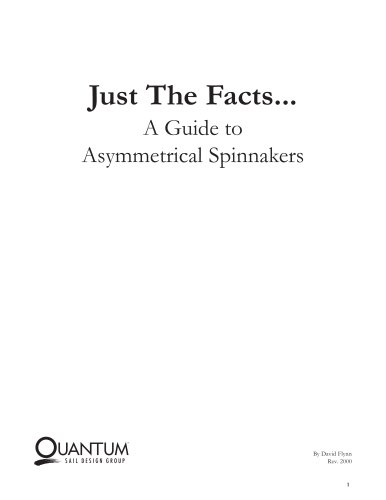
カタログの抜粋

Cruising Sails Choosing the Right Materials and Construction Techniques compiled for QSDG by David Flynn
カタログの1ページ目を開く
CRUISING SAILS / APPROPRIATE TECHNOLOGY Choosing the Right Materials and Construction Type The sail buying equation means balancing off performance versus durability versus dollars. The thing that makes establishing black and white guidelines for what materials and construction type is appropriate for a given application, is the subjectivity of the individual client’s perception of what “a good cruising sail” is. Performance For many, the criteria is simply a sail which goes up and down (or unrolls) when needed, remains intact as a triangle, and costs as little as possible. For this group,...
カタログの2ページ目を開く
The Three Types of Construction: Crosscut, Oriented with Polyester, Oriented with High Modulus Cross Cut The standard for the past thirty years. Utilizes panels oriented from luff to leech. Sails are made from woven polyester (better known by duPont’s trademark for the fiber Dacron®). Ultimate strength of materials is a limiting factor, and stretch is high by comparison to composite materials. “Oriented” Construction Triradial, Genesis, 3DL, and Tape Drive are examples of “oriented” constructions. Oriented means that some attempt is made to align the load bearing fibers in a given material...
カタログの3ページ目を開く
Materials Woven Dacron = Cross Cut Quality Depends On: Type of Fiber Number of Threads ("Picks") per inch Finish Composite Laminates = Tri-Radial Spectr a Pentex , Vectran o (Polye r Dacron® ster) S crim Woven Dacron ® Taffet a Mylar ® Film Woven Dacron ® Taffet a Typical Composite Laminate Cruising Fabric The Bottom Line: Strength to Weight Ratio = Initial Performance (Shape Holding) and Performance Over Time
カタログの4ページ目を開く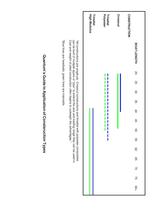
CONSTRUCTION Crosscut Triradial Polyester Triradial High Modulus BOAT LENGTH 20 25 30 35 40 45 50 55 60 65 *All constructions are single ply. Crosscut constructions and triradial with polyester composites can be built of multiple layers or “plys” to extend the size and loading range they can be used in. Cost and weight of plied construction often begins to outweigh the advantages.* *Blue lines are headsails, green lines are mainsails. Quantum’s Guide to Application of Constsruction Types 70 75 80+
カタログの5ページ目を開く
How Much Stronger / How Much Less Stretch? M a t e r i a l W e i g h t 6 . 6 2 H A W o v e n P o l y e s t e r 6 . 7 C X 6 P o l y e s t e r C o m p o s i t e s 6 . 2 9 C X P 6 P e n t e x C o m p o s i t e s o z o z P r i m a r y !% 8 6 l b s B i a s 1 % P r i m a r y S t r e t c h a t 4 0 l b s B i a s S t r e t c h a t 4 0 l b s 2 1 l b s 7.5 4 5 6 2 4 l b s 1 7 0 7.2 1 0 5 2 8 . 5 l b s l b s 2 9 l b s 4 2 4 . 5 S X 1 0 S p e c t r a C o m p o s i t e s 6 . 9 9 o z 4 4 8 l b s 4 6 l b s 2.2 1 4 . 8 7 . 6 2 H A W o v e n P o l y e s t e r 8 . 2 3 o z 1 0 8 l b s 2 3 l b s 5 3 4 C X 7 P o...
カタログの6ページ目を開く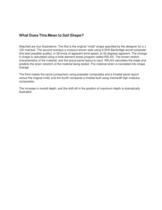
What Does This Mean to Sail Shape? Attached are four illustrations. The first is the original “mold” shape specified by the designer for a J 120 mainsail. The second overlays a crosscut woven sails using 9.3HA Bainbridge woven polyester (the best possible quality), in 28 knots of apparent wind speed, at 30 degrees apparent. The change in shape is calculated using a finite element stress program called RELAX. The known stretch characteristics of the material, and the actual panel layout is input. RELAX calculates the loads and predicts the strain (stretch) of the material being tested. The...
カタログの7ページ目を開く
SHAPE CHANGE J 120 Mainsail T M Woven Dacron Versus Mold AWS 28 AWA 30 Baseline "MOLD" Shape TM 9.3HA Dacron 25% Height .095% to .149% 50% Height .09% to .124% 50% Height .066% to .079%
カタログの8ページ目を開く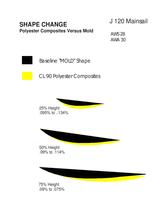
SHAPE CHANGE Polyester Composites Versus Mold Baseline "MOLD" Shape CL 90 Polyester Composites 25% Height .095% to ..134% 50% Height .09% to .114% 75% Height .09% to .075% J 120 Mainsail AWS 28 AWA 30
カタログの9ページ目を開く
SHAPE CHANGE VECTRAN Composites Versus Mold Baseline "MOLD" Shape CL V 15 VECTRAN Composites 25% Height .095% to .098% 50% Height .09% to .092% 75% Height .09% to .069% J 120 Mainsail AWS 28 AWA 30
カタログの10ページ目を開く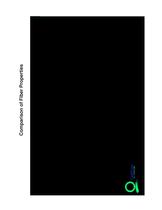
Comparison of Fiber Properties
カタログの11ページ目を開くQuantum Sailsのすべてのカタログとパンフレット
-
MAINSAIL TRIM GUIDE
4 ページ
-
IQ Technology Sheet
3 ページ
-
Matte film brochure
4 ページ
-
cruising - woven
4 ページ
-
cruising
4 ページ
-
racing - spinnaker
4 ページ
-
racing
4 ページ
-
210
11 ページ
-
Beneteau First 36.7
1 ページ
-
Fusion_M
16 ページ
カタログアーカイブ
-
PROPER SAIL CARE
1 ページ















